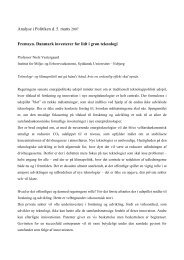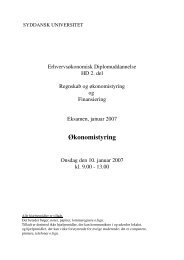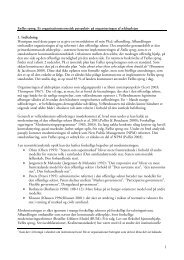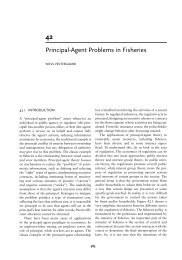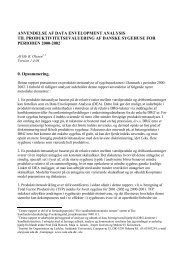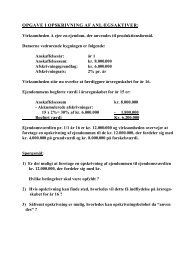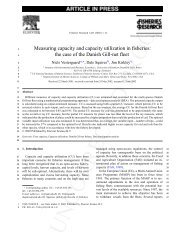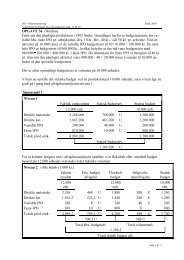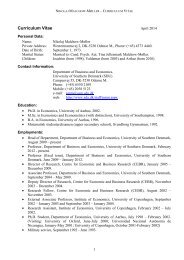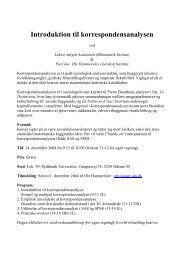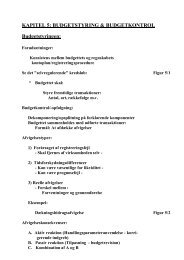Development of Parties and Party Systems in ... - lah@sam.sdu.dk
Development of Parties and Party Systems in ... - lah@sam.sdu.dk
Development of Parties and Party Systems in ... - lah@sam.sdu.dk
- No tags were found...
Create successful ePaper yourself
Turn your PDF publications into a flip-book with our unique Google optimized e-Paper software.
. consolidationthe ”two turn over testen” passedfair <strong>and</strong> free electionsfair play between government <strong>and</strong> oppositionformation <strong>of</strong> stronger civile societiesrule by lawsdepersonalization, rut<strong>in</strong>ization <strong>and</strong> erosion <strong>of</strong> charismakonsensualism <strong>and</strong> consocietalismde-ideologisation <strong>and</strong> pragmatisationfreez<strong>in</strong>g <strong>and</strong> de-freez<strong>in</strong>g <strong>of</strong> cleavages<strong>in</strong>stitutionalisationfunctional market economy1.2. Political parties <strong>and</strong> party systemsPolitical parties can be def<strong>in</strong>ed <strong>in</strong> m<strong>in</strong>imalistic ways, <strong>in</strong> which case they may be considered as “anypolitical group that presents at elections <strong>and</strong> is capable <strong>of</strong> placer<strong>in</strong>g through elections c<strong>and</strong>idates forpublic <strong>of</strong>fice” (Sartori, 1976:64), <strong>in</strong> opposition to the more maximalistic <strong>and</strong> dem<strong>and</strong><strong>in</strong>gformulations, used by Jan-Erik Lane <strong>and</strong> Svante Ersson (Lane <strong>and</strong> Ersson, 1999:132), who say that“political parties are organized collectivities orientated towards the pursuit <strong>of</strong> some comb<strong>in</strong>ation<strong>of</strong> the goal <strong>of</strong> electoral success <strong>and</strong> <strong>in</strong> the end <strong>of</strong> political effectiveness, i.e. the capacity <strong>of</strong> parties tohave an impact upon government policy-mak<strong>in</strong>g. Differences <strong>in</strong> strategy <strong>and</strong> tactics between partiesmay help expla<strong>in</strong> the variation <strong>in</strong> the capacity <strong>of</strong> parties to cope with a chang<strong>in</strong>g if not turbulentenvironment”.Us<strong>in</strong>g a more maximalist def<strong>in</strong>ition the dem<strong>and</strong> <strong>of</strong> a more robust party organisation can be<strong>in</strong>cluded. Seen <strong>in</strong> a functionalistic perspective the parties must be able to recruit people to importantposts <strong>in</strong> society, control <strong>and</strong> coord<strong>in</strong>ate <strong>and</strong> secure more quality <strong>and</strong> stability <strong>in</strong> publicadm<strong>in</strong>istration. Moreover, parties are considered as political associations which by compet<strong>in</strong>g withother parties take part <strong>in</strong> election campaigns with the aim to ga<strong>in</strong> governmental power <strong>and</strong> tak<strong>in</strong>gresponsibility for the state 1 . <strong>Parties</strong> may also be seen as functional agencies, as they serve specific1 Inka Slo<strong>dk</strong>owska,”Partie i ugrupowania polityczne polskiej transformacji”, <strong>in</strong>: Jacek Wasilewski (ed), 1997.7



